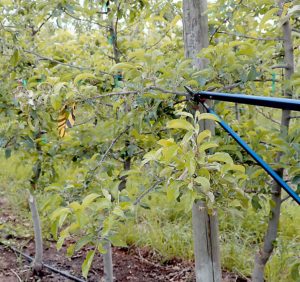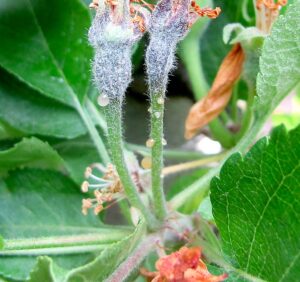Washington State University Extension released the following reminder for growers in areas prone to fire blight outbreaks.
Fire blight reminders
With warm conditions in the previous three days, fire blight temperature risk is high in many parts of Washington state. We have had first reports of oozing, overwintering cankers telling us fire blight inoculum is present. Pear blooms are starting to open in early areas. Serious blight outbreaks have occurred in past years when degree-hours are near or exceed current conditions and open blossoms are wetted by rain, dew or light irrigation. Consider the following reminders as you begin your fire blight prevention programs.
Risk
After fire blight infections in 2023, there is likely to be more overwintering inoculum. With fire blight more likely to be in the area, we are more likely to have severe infections this year if temperatures are warm and wet during bloom. The risk of severe damage due to infection increases in later stages of primary bloom and petal fall until late bloom is finished.
Use products with high efficacy
Check product efficacy on the WSU fire blight webpage (https://treefruit.wsu.edu/crop-protection/disease-management/fire-blight/#materials) or the WSU Crop Protection Guide (https://cpg.treefruit.wsu.edu/apple-programs/overview/#bloom).
Apply products BEFORE an infection event
Consider how each antibiotic works when deciding which to use. Antibiotics have the highest efficacy when applied shortly before a moisture event. While kasugamycin and streptomycin can also be applied up to 12 hours after a moisture event, efficacy is greatly reduced. Streptomycin has locally systemic activity, and kasugamycin is effective on bacteria that have been washed into the floral cup but not yet invaded the flower (for a short time). Oxytetracycline is considered bacteriostatic (inhibits bacterial growth). Thus, to be effective it must be applied prior to rains where it can prevent growth on stigmas.
Optimize your spray by buffering
All WSU antibiotic trials are done with tank water buffered to 5.6. At higher pH, antibiotics are not as effective. This is because both the residual of the antibiotic is much longer at a lower pH and because the low pH itself reduces bacterial growth. Research by Ken Johnson at Oregon State University showed that buffering to pH 4 can further improve antibiotic efficacy.
Additional resources
For more information, contact Tianna DuPont, WSU Extension, by email at: Tianna.dupont@wsu.edu or by phone at: 509-713-5346.
You can also check these Good Fruit Grower stories from our archive:
—by Jonelle Mejica








Leave A Comment